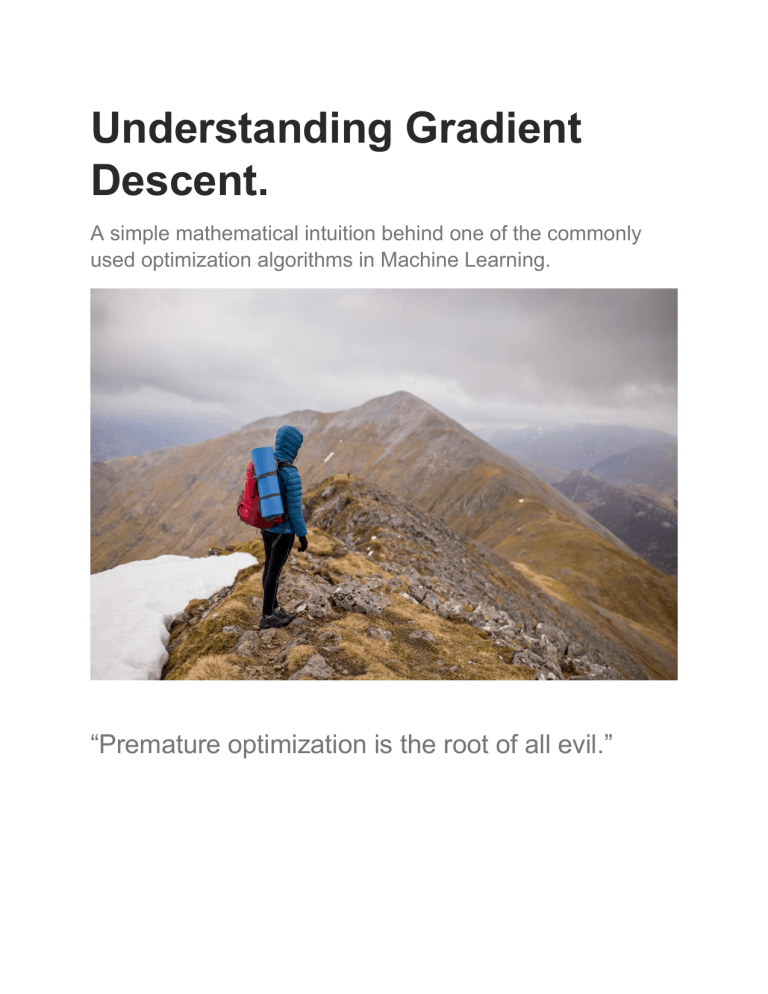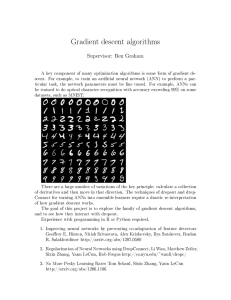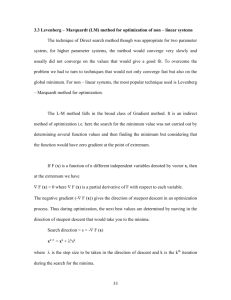
Understanding Gradient
Descent.
A simple mathematical intuition behind one of the commonly
used optimization algorithms in Machine Learning.
“Premature optimization is the root of all evil.”
The idea of — start with a solution as soon as possible (Z. Chen,
Zhou, Xu, & Liang, 2021), measure and iterate as frequently as
possible, is Gradient descent under the hood (Lee et al., 2019).
Objective
Gradient descent algorithm is an iterative process that takes us to
the minimum of a function(barring some caveats/limits). The
formula below sums up the entire Gradient Descent algorithm in a
single line.
https://www.coursehero.com/file/27927651/Gradient-Descentpdf/
But how do we arrive at this formula? Well, It is straightforward
and includes some high school maths. Through this article, we
shall try to understand and recreate this formula in the context of
a Linear Regression model.
This article is an adaption of the video titled Mathematics of
Gradient Descent — Intelligence and Learning by The
Coding Train. This article was initially created as notes
to supplement my understanding. I’ll highly
recommend to see the video too.
A Machine Learning Model
•
Consider a bunch of data points in a 2 D space.
Assume that the data is related to the height and
weight of a group of students. We are trying to
predict some relationship between these quantities
to predict the weight of some new students
afterward. This is essentially a simple example of a
supervised Machine Learning technique (Camacho,
Panizo-LLedot, Bello-Orgaz, Gonzalez-Pardo, &
Cambria, 2020; Ch, Srivastava, Gadekallu,
Maddikunta, & Bhattacharya, 2020; C. Chen, Zhu,
& Hammad, 2020; Cherpitel, Karriker-Jaffe, Li, &
Zemore, 2020).
•
Let us now draw an arbitrary line in space that
passes through some of these data points. The
equation of this straight line would be Y = mX +
b
where m is the slope and b is its intercept on the
Y-axis.
Predictions
Given a known set of inputs and their corresponding outputs, A
machine learning model tries to make some predictions for a new
set of inputs.
ML process
The Error would be the difference between the two predictions.
This relates to the idea of a Cost function or Loss function.
Cost Function
A Cost Function/Loss Function evaluates the performance of
our Machine Learning Algorithm. The Loss function computes
the error for a single training example, while the Cost function is
the average of the loss functions for all the training examples.
Henceforth, I shall be using both the terms interchangeably.
A Cost function basically tells us ‘ how good’ our
model is at making predictions for a given value of
m and b.
Let’s say there are a total of ’N’ points in the dataset, and for all
those ’N’ data points, we want to minimize the error. So the Cost
function would be the total squared error i.e
The cost function for N data points
Why do we take the squared differences and simply not the
absolute differences? Because the squared differences make it
easier to derive a regression line. Indeed, to find that line we need
to compute the first derivative of the Cost function, and it is much
harder to compute the derivative of absolute values than squared
values. Also, the squared differences increase the error distance,
thus, making the bad predictions more pronounced than the good
ones.
Minimizing the Cost Function
The goal of any Machine Learning Algorithm is to
minimize the Cost Function.
This is because a lower error between the actual and predicted
values signifies that the algorithm has done an excellent job
learning. Since we want the lowest error value, we want
those‘ m’ and ‘b’ values that give the smallest possible error.
How do we minimize any function?
If we look carefully, our Cost function is of the form Y = X² . In a
Cartesian coordinate system, this is an equation for a parabola and
can be graphically represented as :
Parabola
To minimize the function above, we need to find that value
of X that produces the lowest value of Y which is the red
dot. It is pretty easy to locate the minima here since it is a 2D
graph, but this may not always be the case, especially in higher
dimensions. For those cases, we need to devise an algorithm to
locate the minima, and that algorithm is called Gradient
Descent.
Gradient Descent
Gradient descent is one of the most popular algorithms to
perform optimization and is the most common way to optimize
neural networks. It is an iterative optimization algorithm used to
find the minimum value for a function.
Intuition
Consider that you are walking along with the graph below, and you
are currently at the ‘green’ dot. You aim to reach the minimum,
i.e., the ‘red’ dot, but from your position, you are unable to view it.
Figure 2
Possible actions would be:
•
You might go upward or downward
•
If you decide which way to go, you might take a
bigger step or a little step to reach your destination.
Essentially, there are two things that you should
know to reach the minima, i.e. which way to go
and how big a step to take.
Gradient Descent Algorithm helps us to make these decisions
efficiently
and
effectively
with
the
use
of
derivatives.
A derivative is a term that comes from calculus and is calculated
as the slope of the graph at a particular point. The slope is
described by drawing a tangent line to the graph at the point. So, if
we can compute this tangent line, we might compute the desired
direction to reach the minima. We will talk about this in more
detail in the latter part of the article.
The Minimum Value
In the same figure, if we draw a tangent at the green point, we
know that if we are moving upwards, we are moving away from the
minima and vice versa. Also, the tangent gives us a sense of the
steepness of the slope.
The slope at the blue point is less steep than that at the green
point, which means it will take much smaller steps to reach the
minimum from the blue point than from the green point.
Mathematical Interpretation of Cost Function
Let us now put all these learnings into a mathematical formula. In
the equation, y
= mX+b
‘m’ and ‘b’ are its parameters. During the
training process, there will be a small change in their values. Let
that small change be denoted by δ. The value of parameters will be
updated as m=m-δm and b=b-δb, respectively. Our aim here is
to find those values of m and b iny
= mx+b
For which the error is
minimum, i.e., values that minimize the cost function.
Rewriting the cost function:
The idea is that by computing the derivative/slope
of the function, we can find the minimum of a
function.
The Learning rate
This size of steps taken to reach the minimum or bottom is
called Learning Rate. We can cover more area with larger
steps/higher learning rate but are at the risk of overshooting the
minima. On the other hand, small steps/smaller learning rates will
consume a lot of time to reach the lowest point.
The visualizations below give an idea about the Learning Rate
concept.
See how in the third figure, we reach the minimum point
with the minimum number of steps. This is the optimum
learning rate for this problem.
Source
We saw that when the learning rate is too low, it takes many steps
to converge. On the other hand, when the learning rate is too high,
Gradient Descent fails to reach the minimum, as seen in the
visualization below.
Source
Experiment with different learning rates by visiting the link below.
Optimizing Learning Rate | Machine Learning Crash Course | Google Developers
Can you reach the minimum more quickly with a higher learning rate? Set a
learning rate of 1, and keep hitting STEP…
developers.google.com
Derivatives
Machine learning uses derivatives in optimization problems.
Optimization algorithms like gradient descent use derivates to
decide whether to increase or decrease the weights to increase or
decrease any objective function.
If we are able to compute the derivative of a
function, we know in which direction to proceed to
minimize it.
Primarily we shall be dealing with two concepts from calculus :
•
Power Rule
Power rule calculates the derivative of a variable raised to a power.
•
Chain Rule
The chain rule is used for calculating the derivative of composite
functions. The chain rule can also be expressed in Leibniz’s
notation as follows:
If a variable z depends on the variable y, which itself depends on
the variable x, so that y and z are dependent variables, then z, via
the intermediate variable of y, depends on x as well. This is called
the chain rule and is mathematically written as,
Let us understand it through an example:
•
Using the Power and Chain Rule for derivatives, let’s
calculate how the Cost function changes relative to m and
c. This deals with the concept of partial
derivatives, which says that if there is a function of two
variables, then to find the partial derivative of that
function w.r.t to one variable, treat the other variable as
constant. This will be more clear with an example:
Calculating Gradient Descent
Let us now apply the knowledge of these rules of calculus in our
original equation and find the derivative of the Cost Function w.r.t
to both ‘m’ and ‘b’. Revising the Cost Function equation :
For simplicity, let us get rid of the summation sign. The
summation part is important, especially with the concept
of Stochastic gradient descent (SGD ) vs. batch gradient
descent. During the batch gradient descent, we look at the
error of all the training examples at once, while in the SGD, we
look at each error at a time. However, to keep things simple, we
will assume that we are looking at each error one at a time.
Now let’s calculate the gradient of Error w.r.t to both m and b :
Plugging the values back in the cost function and multiplying it
with the learning rate:
This 2 in this equation isn’t that significant since it just says that
we have a learning rate twice as big or half as big. So let’s get rid of
it too. So, Ultimately, this entire article boils down to two simple
equations representing the equations for Gradient Descent.
m¹,b¹ = next position parameters; m⁰,b⁰ = current position
parameters
Hence,to solve for the gradient, we iterate through our data
points using our new m and b values and compute the partial
derivatives. This new gradient tells us the slope of our cost
function at our current position and the direction we should move
to update our parameters. The size of our update is controlled by
the learning rate.
Conclusion
The point of this article was to demonstrate the concept of
gradient descent. We used gradient descent as our optimization
strategy for linear regression. by drawing the line of best fit to
measure the relationship between student heights and weights.
However, it is important to note here that the linear regression
example has been chosen for simplicity but can be used with other
Machine Learning techniques
Camacho, D., Panizo-LLedot, Á., Bello-Orgaz, G., Gonzalez-Pardo, A., & Cambria, E. (2020). The four
dimensions of social network analysis: An overview of research methods, applications, and
software tools. Information Fusion, 63, 88-120.
Ch, R., Srivastava, G., Gadekallu, T. R., Maddikunta, P. K. R., & Bhattacharya, S. (2020). Security and
privacy of UAV data using blockchain technology. Journal of Information Security and
Applications, 55, 102670.
Chen, C., Zhu, Z., & Hammad, A. (2020). Automated excavators activity recognition and productivity
analysis from construction site surveillance videos. Automation in construction, 110, 103045.
Chen, Z., Zhou, Y., Xu, T., & Liang, Y. (2021). Proximal Gradient Descent-Ascent: Variable Convergence
under K {\L} Geometry. arXiv preprint arXiv:2102.04653.
Cherpitel, C. J., Karriker-Jaffe, K. J., Li, L., & Zemore, S. E. (2020). Neighborhood Context and Drug Use
Among Mexican Americans on and off the US–Mexico Border. Journal of studies on alcohol and
drugs, 81(6), 770-780.
Lee, J., Xiao, L., Schoenholz, S., Bahri, Y., Novak, R., Sohl-Dickstein, J., & Pennington, J. (2019). Wide
neural networks of any depth evolve as linear models under gradient descent. Advances in
neural information processing systems, 32, 8572-8583.



